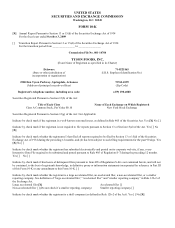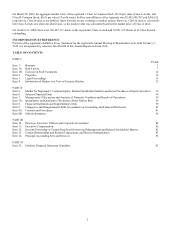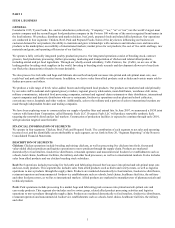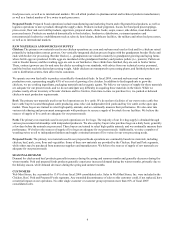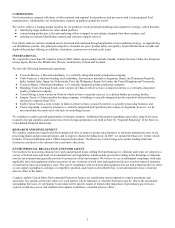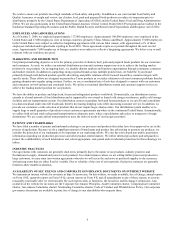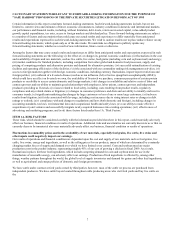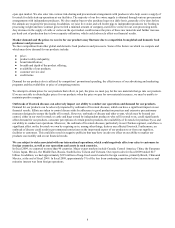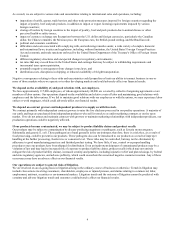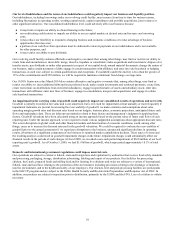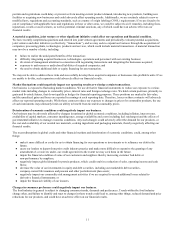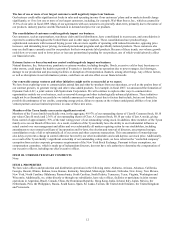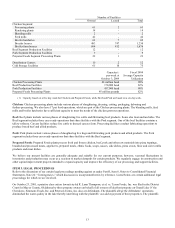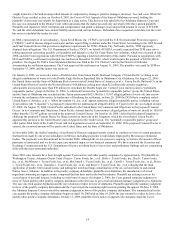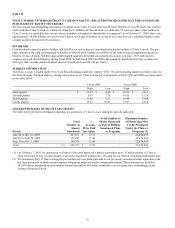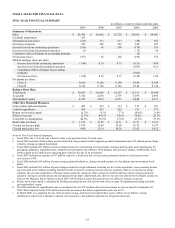Tyson Foods 2009 Annual Report Download - page 8
Download and view the complete annual report
Please find page 8 of the 2009 Tyson Foods annual report below. You can navigate through the pages in the report by either clicking on the pages listed below, or by using the keyword search tool below to find specific information within the annual report.8
open spot market. We also enter into various risk-sharing and procurement arrangements with producers who help secure a supply of
livestock for daily start-up operations at our facilities. The majority of our live swine supply is obtained through various procurement
arrangements with independent producers. We also employ buyers who purchase hogs on a daily basis, generally a few days before
the animals are required for processing. In addition, we raise live swine and sell feeder pigs to independent producers for feeding to
processing weight and have contract growers feed a minimal amount of company-owned live swine for our own processing needs.
Any decrease in the supply of cattle or swine on the spot market could increase the price of these raw materials and further increase
per head cost of production due to lower capacity utilization, which could adversely affect our financial results.
Market demand and the prices we receive for our products may fluctuate due to competition from global and domestic food
producers and processors.
We face competition from other global and domestic food producers and processors. Some of the factors on which we compete and
which may drive demand for our products include:
●
price;
●
product safety and quality;
●
brand identification;
●
breadth and depth of the product offering;
●
availability of our products;
●
customer service; and
●
credit terms.
Demand for our products also is affected by competitors’ promotional spending, the effectiveness of our advertising and marketing
programs and the availability or price of competing proteins.
We attempt to obtain prices for our products that reflect, in part, the price we must pay for the raw materials that go into our products.
If we are not able to obtain higher prices for our products when the price we pay for raw materials increases, we may be unable to
maintain positive margins.
Outbreaks of livestock diseases can adversely impact our ability to conduct our operations and demand for our products.
Demand for our products can be adversely impacted by outbreaks of livestock diseases, which can have a significant impact on our
financial results. Efforts are taken to control disease risks by adherence to good production practices and extensive precautionary
measures designed to ensure the health of livestock. However, outbreaks of disease and other events, which may be beyond our
control, either in our own livestock or cattle and hogs owned by independent producers who sell livestock to us, could significantly
affect demand for our products, consumer perceptions of certain protein products, the availability of livestock for purchase by us and
our ability to conduct our operations. Moreover, the outbreak of livestock diseases, particularly in our Chicken segment, could have a
significant effect on the livestock we own by requiring us to, among other things, destroy any affected livestock. Furthermore, an
outbreak of disease could result in governmental restrictions on the import and export of our products to or from our suppliers,
facilities or customers. This could also result in negative publicity that may have an adverse effect on our ability to market our
products successfully and on our financial results.
We are subject to risks associated with our international operations, which could negatively affect our sales to customers in
foreign countries, as well as our operations and assets in such countries.
In fiscal 2009, we exported to more than 90 countries. Major export markets include Canada, Central America, China, the European
Union, Japan, Mexico, the Middle East, Russia, South Korea, Taiwan and Vietnam. Our export sales for fiscal 2009 totaled $2.7
billion. In addition, we had approximately $329 million of long-lived assets located in foreign countries, primarily Brazil, China and
Mexico, at the end of fiscal 2009. In fiscal 2009, approximately 3% of the loss from continuing operations before income taxes and
minority interest was from foreign operations.

